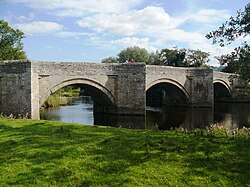Ulshaw Bridge Village
| Ulshaw Bridge | |
| Yorkshire North Riding | |
|---|---|
 Bridge over the River Ure at Ulshaw | |
| Location | |
| Grid reference: | SE145872 |
| Location: | 54°16’52"N, 1°46’41"W |
| Data | |
| Post town: | Leyburn |
| Postcode: | DL8 |
| Local Government | |
| Council: | North Yorkshire |
Ulshaw Bridge is a hamlet in Wensleydale, beside the River Ure, near to Middleham, in the North Riding of Yorkshire. The River Cover joins the Ure at Ulshaw Bridge. The hamlet derives its name partly from the Mediæval stone bridge, also known as Ulshaw Bridge, which spans the River Ure to the immediate south of the hamlet. Ulshaw Bridge is two and a half miles west of Thornton Steward, and just over a mile east of Middleham.[1]
History
This is Ulshaw Bridge is believed to have been a crossing point over the Ure since Roman times. The Roman Road which crossed at this point, is believed to have led towards Addlebrough.[2]
The hamlet of Ulshaw Bridge is shown on mapping as being on either side of the bridge straddling the River Ure, though most houses and the Roman Catholic church are on the north bank of the river. The name Ulshaw is first recorded in 1158 as Wolueshowe, which is believed to have derived from the Old Norse of Ulf and Haugr (Ulf's mound).[3] Ulshaw has been mentioned as the possible location where Oswin, King of Deira, dismissed his army so that he could retire to a monastery.[4][5] However Speight states that this is a mis-recording, and that the location is ten miles north-west of Catterick, not the south west.[6]
In 1563, when the Black Death ravaged nearby East Witton, the market was moved from there and held at Ulshaw Bridge instead, however it was noted as having been unable to be resurrected at East Witton.[7] The bridge itself is undated, though it has been recorded that Ralph Neville, 1st Earl of Westmorland left £20 in his will of 1424 towards the building of the bridge,[8] described as the "Houseway Bridge over the [River] Eure".[9] The structure was originally believed to have been built in timber, but was constructed of stone between 1673 and 1674.
Ulshaw Bridge is now grade II listed, including a sundial located above one of the piers.[10]
The church of Saint Peter and Saint Jude, is to the east of the bridge and is unusual to be a Roman Catholic church in a small Yorkshire hamlet.[4] This is because the church, which was rebuilt around 1867–1868 by Joseph Hansom in the Byzantine style, is a direct replacement for the Roman Catholic chapel at nearby Danby Hall, seat of the Scrope family. The Scropes were long a recusant family and maintained the tradition despite the penalties suffered from the time of Elizabeth I.[11] The present church building is accessed by an open staircase which leads to a south door.[12] The church is grade II listed and the tower is prominent in the landscape.[13]
Historically, the hamlet was in the manor of Wensley (recorded in 1277),[14] and was listed as being in the wapentake of Hang West, and the parish of East Witton.
See also
Outside links
References
- ↑ Mogg, Edward (1824). Paterson's Roads ... The sixteenth edition ... Remodelled, augmented, and improved. London: Longman. p. 538. OCLC 563806923.
- ↑ Bogg, Edmund (1894). From Edenvale to the plains of York : or, a thousand miles in the valleys of Nidd and Yore. Leeds: Edmund Bogg. p. 267. OCLC 931337530.
- ↑ Place-Names
- ↑ 4.0 4.1 "Countryman's Diary - Tragedy that touches so many". The Northern Echo. 16 March 2001. https://www.thenorthernecho.co.uk/news/7115144.countrymans-diary---tragedy-touches-many/.
- ↑ Whellan, T (1859). History and topography of the city of York and the North Riding of Yorkshire; embracing a general review of the early history of Great Britain, and a general history and description of the County of York. York: John Green. p. 452. OCLC 963782088.
- ↑ Speight 1897, p. 172.
- ↑ Information on Ulshaw Bridge Village from GENUKI
- ↑ Speight 1897, p. 347.
- ↑ Swallow, H. J. (3 October 1884). "De Nova Villa; or, the House of Nevill in the sunshine and shade". Newcastle Courant (Column B) (10942): p. 2. OCLC 639739794.
- ↑ National Heritage List 1021078: Ulshaw Bridge (Grade II listing)
- ↑ "Revealing the proud history of a small Dales community". Darlington and Stockton Times. 16 January 2009. https://www.darlingtonandstocktontimes.co.uk/news/4052955.revealing-the-proud-history-of-a-small-dales-community/.
- ↑ Nikolaus Pevsner: The Buildings of England: Yorkshire: The North Riding, 1966 Penguin Books ISBN 978-0-300-09665-1page 153
- ↑ National Heritage List 1179704: Church of St Simon and St Jude (Grade II listing)
- ↑ Speight 1897, p. 381.
- Speight, Harry (1897). Romantic Richmondshire. Being a complete account of the history, antiquities and scenery of the picturesque valleys of the Swale and Yore. London: E Stock. OCLC 7241488.